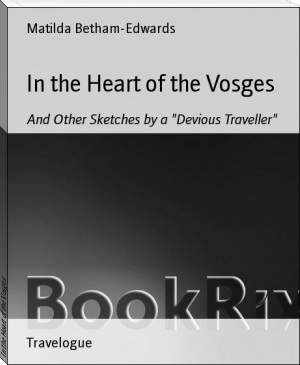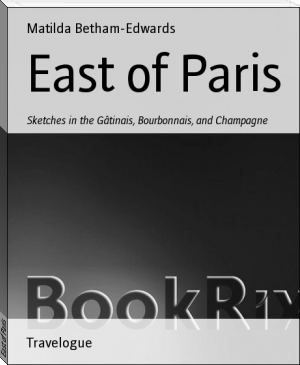Holidays in Eastern France by Matilda Betham-Edwards (best free ebook reader TXT) 📖

- Author: Matilda Betham-Edwards
Book online «Holidays in Eastern France by Matilda Betham-Edwards (best free ebook reader TXT) 📖». Author Matilda Betham-Edwards
Provins affords an excellent example of that spirit of decentralization so usual in France, and unhappily so rare among ourselves. Here in a country town, numbering between seven and eight thousand inhabitants only, we find all the resources of a capital on a small scale; Public Library, Museum, Theatre, learned societies. The Library contains some curious MSS. and valuable books. The Theatre was built by one of the richest and most generous citizens of Provins, M. Gamier, who may be said to have consecrated his ample fortune to the embellishment and advancement of his native town. Space does not permit of an enumeration of the various acts of beneficence by which he has won the lasting gratitude of his fellow-townsmen; and on his death the charming villa he now inhabits, with its gardens, library, art and scientific collections, are to become the property of the town. The Rue Victor Garnier has been appropriately named after this public-spirited gentleman.
There are relics of antiquity to be found in the modern town also; nor have I given anything like a complete account of what is to be found in the old. No one who takes the trouble to diverge from the beaten track in order to visit this interesting little city--Weimar of the Troubadours--will be disappointed. I may add, by the way, that the Hotel de la Boule d'Or, though homely, is comfortable, and that in this out of the way corner the English traveller is invited to partake of the famous "Biere de Bass."
From Provins to Troyes is a three hours' journey by rail; and at Troyes, no matter how impatient the tourist may be to breathe the air of the mountains, he must stop awhile. Here there is so much to see in the way of antiquities that several days might be spent profitably and pleasantly, but for the hotels, of which I have little favourable to say. "Dear and dirty," is the verdict I must pass on the one recommended to me as the best; the fastidious traveller will do well, therefore, so to arrange his journey as to reach Troyes at early morning, and start off again at night; though, of course, such an arrangement will only allow of a hasty glimpse of the various treasures offered to him. Take the churches, for instance. Besides the Cathedral, there are six old churches, each of which has some especial interest, and all deserve to be seen in detail. Then there are picturesque mediaeval houses, one of the first libraries in France, a museum, picture-gallery, &c.
The town itself is cheerful, with decorative bits of window-gardening, hanging dormers, abundance of flowers growing everywhere, and much life animating its old and new quarters. The Cathedral, which rises grandly from the monotonous fields of Champagne, just as Ely towers above the flat plains of our Eastern counties, is also seen to great advantage from the quays, though, when approached nearly, you find it hemmed in with narrow streets. Its noble towers, surmounted by airy pinnacles, and its splendid facade, delight the eye no less than the interior--gem of purest architecture blazing from end to end with rich old stained glass. No light here penetrates through the common medium, and the effect is magical; the superb rose and lancet windows, not dazzling, rather captivating the vision with the hues of the rainbow, being made up, as it seems, with no commoner materials than sapphire, emerald, ruby, topaz, amethyst, all these in the richest imaginable profusion. Other interiors are more magnificent in architectural display, none are lovelier than this, and there is nothing to mar the general harmony, no gilding or artificial flowers, no ecclesiastical trumpery, no meretricious decoration. We find here the glorious art of painting on glass in its perfection, and some of the finest in the Cathedral, as well as in other churches here, are the work of a celebrated Troyen, Linard Gonthier.
A sacristan is always at hand to exhibit the treasury, worth, so it is said, some millions of francs, and which is to be commended to all lovers of jewels and old lace. The latter, richest old guipure, cannot be inspected by an amateur, or, indeed, a woman, without pangs. Such treasures as these, if not appropriated to their proper use, namely dress and decoration, should, at least, be exhibited in the Town Museum, where they might be seen and studied by the artistic. There are dozens of yards of this matchless guipure, but, of course, few eyes are ever rejoiced by the sight of it; and as I turned from one treasure to another, gold and silver ecclesiastical ornaments, carved ivory coffers, enamels, cameos, embroideries, inlaid reliquaries and tapestries, I was reminded of a passage in Victor Hugo's last poem--Le Pape--wherein the Pope of his imagination, thus makes appeal to the Cardinals and Bishops in conclave:
"Pretre, a qui donc as-tu pris tes richesses? Aux pauvres.
Quand l'or s'enfle dans ton sac, Dieu dans ton coeur decroit;
Apprends qu'on est sans pain et sache qu'on a froid.
Les jeunes filles vont rodant le soir dans l'ombre,
Tes rochets, tes chasubles, aux topazes sans nombre,
Ta robe en l'Orient dore s'epanouit,
Sont de spectres qui sont noirs et vivant la nuit.
Que te sert d'empiler sur des planches d'armoires,
Du velours, du damas, du satin, de la moire,
D'avoir des bonnets d'or et d'emplir des tiroirs
Des chapes qu'on dirait couvertes de miroirs?
Oh! pauvres, que j'entends raler, forcats augustes,
Tous ces tresors, chez vous sacres, chez nous sont injustes;
Ce diamant qui met a la mitre un eclair,
Cette emeraude me semble errer toute la mer,
Ces resplendissements sombres de pierreries,
C'est votre sang ...
... Brodes d'or, cousus d'or, chausses d'or, coiffes d'or,
Nous avons des saints Jeans et des saintes Maries,
Que nous emmaillottons dans des verroteries,
Nous depensons Golconde a vetir le neant,
... Pretres, votre richesse est un crime flagrant.
Vos erreurs sont-ils mechants? Non, vos tetes sont dures,
Freres, j'avais aussi sur moi ce tas d'ordures,
Des perles, des onyx, des saphirs, des rubis,
Oui, j'avais sur moi, partout, sur mes habits,
Sur mon ame; mais j'ai vide bien vite
Chez les pauvres."
The sacristan exhibited a tooth of St. Peter and skulls of the saints, but these are treasures we can look on without envy. This little Museum--as, indeed, the Treasury may be called--exposed at the Paris Exhibition of 1867 one of its richest objects, the reliquary of St. Bernard and St. Malachi, a chef-d'oeuvre of the twelfth century; but as some of the jewels were stolen upon that occasion, nothing this year, very naturally, found its way from Troyes Cathedral to the Trocadero.
Close to the Cathedral are the Town Library, Museum, and Picture Gallery, the two first well worth careful inspection. The famous Library has largely contributed to the historic galleries of the Trocadero; but, nevertheless, many exquisite specimens of binding, printing, and illuminating remain; whilst the windows are adorned with most curious and beautiful old glass paintings from the hand of the gifted Linard Gonthier before mentioned. It is hardly necessary to say that strangers are admitted to all the privileges of the reading-room without any form whatever. The library contains a hundred and some odd thousand volumes, besides between two and three thousand rare MSS.
The present population of Troyes is forty thousand; and I am not aware of any small town in England so well off in the matter of books. The Museum is divided into several sections, and, though of recent date, it possesses some interesting and valuable collections. Near the Library and Museum is the most beautiful old church in Troyes, St. Urbain, but as it is unfortunately in the hands of the restorer, we can see nothing of the interior, and the splendid Gothic facade is partly hidden by scaffolding. The traveller may next proceed on a voyage of discovery, coming upon the picturesque Hotel de Ville; quaint relics of mediaeval architecture, and half a dozen old churches, all noteworthy from some point of view.
It is impossible to do more than suggest the rewards that await such an explorer. Troyes, like Angers and Poitiers, abounds in architectural treasures and historical souvenirs; and all these cities cannot be visited too soon. Restoration and renovation are here, as elsewhere, the order of the day, and every year takes something from their character and charm. Two objects, particularly striking amongst so many, shall be mentioned only, as no mere description can convey any idea of the whole. The first is the entrance hall of the Hotel Vauluisant, the features of which should be photographed for the benefit of art-schools and art-decorators generally. The first is a magnificent oak ceiling; the second, a Renaissance chimney piece in carved wood, no less magnificent. The solidity, richness of design, and workmanship of both ceiling and mantel-piece afford an invaluable lesson to artists, whilst beholders can but examine them without a feeling of sadness.
How little we have in modern art-furniture and decoration to be compared with such an achievement: Here we find that cost, labour, and display went for nothing, and artistic perfection alone was aimed at. Not far from the Hotel Vauluisant is Ste. Madeleine, the most ancient church in Troyes, originally Gothic, but now, what with dilapidations and restorations, a curious medley of all various styles. To its architecture, however, the traveller will pay little heed, his whole attention being at once transferred to the famous jube, or rood-loft, or what passes by that name. Bather let me call it a curtain of rare lace cut out in marble, a screen of transparent ivory, a light stalactite roof of some fairy grotto!
On entering, you see nothing but this airy piece of work, one of the daintiest, richest creations of the period, the achievement of Juan Gualde in the sixteenth century. The proportions of the interior seem to diminish, and we cannot help fancying that the church was built for the rood-loft, rather than the rood-loft for the church, so dwarfed is the latter by comparison. The centre aisle is indeed bridged over by a piece of stone-carving, so exquisite in design, so graceful in detail, so airy and fanciful in conception, that we are with difficulty brought to realize its size and solidity. This unique rood-loft measures over six yards in depth, is proportionately long, and is symmetrical in every part, yet it looks as if a breath were only needed to disperse its delicate galleries, hanging arcades, and miniature vaults, gorgeous painted windows forming the background--jewels flashing through a veil of guipure. English travellers may be reminded that Shakespeare's favourite hero, Henry V., was married to Katherine of France in the ancient church of St. Jean at Troyes, now the oldest congeries of different kinds of architecture. The betrothal took place before the high altar of Troyes Cathedral. Lovers of old stained glass must visit St. Nizier and other old churches here; all possess some peculiar interest either within or without.
Troyes--from the standard weight of which we have our Troy weight--is the birth-place of many illustrious men. Mignard the painter, Girardon, sculptor, whose monument to Richelieu in the church of the Sorbonne will not fail to be visited by English travellers, and of the famous painter on glass, Linard Gonthier, who had engraved on his tomb that he awaited the





Comments (0)